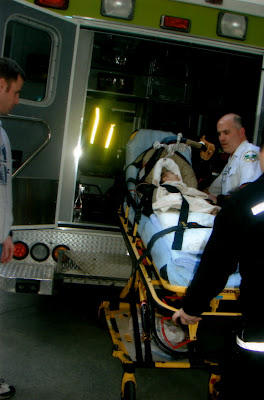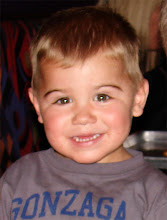As soon as I typed that title, gratitude flooded me that Luke and I were just playing ambulance and not actually re-experiencing his ride from Tacoma to Seattle four years ago.
As we were playing on the floor, I reminded him that he got to ride in an ambulance one time when he was a baby. "Do you want to see a picture?" He did, so we headed downstairs to pull out the photo albums. That set of pictures also included pictures of the hospital cribs, NG tubes and nasal cannula and a red angry scar that had yet to turn a nice faded white. We hadn't looked at these pictures for a while, so I was watchful as to how Luke would react to them. He didn't seem bothered by them, just curious. "Did I cry when that yellow tube was in my nose?" "Was I at the hospital to get a flu shot?" (Nothing is worse than a flu shot in Luke's brain! Honestly, if you asked him if he'd rather have a flu shot or open heart surgery, he would pick the surgery.) And then this question: "Will baby sister cry when she gets her heart fixed?"
I was floored. Luke has never made a big deal of his scar, or even seemed to take much notice of it, so I have always thought that, in relation to others, he doesn't see himself as a boy with a different heart. But maybe I was wrong. Maybe, instead, he lives as though it's normal to need to get your heart fixed, and that just like being born, or getting flu shots, it is something that everyone experiences.
I told him that baby sister doesn't need to get her heart fixed, that God only made Luke's heart special in our family. He was totally fine with that answer and was ready to go play more ambulance. Most encouraging to me from that question, is the fact that Luke truly doesn't feel different, or perceive himself as different, from his friends. Roger and I want to foster that attitude for as long as possible. It won't be forever, but at four, we love that his heart isn't a defect, but simply a fact of life.
I had ordered Luke a Medical ID bracelet a few months ago, etched with his name, diagnosis, medications, and O2 sats. I thought he might be old enough to start wearing it at preschool, or when he is on a playdate and I'm not there. My husband (a teacher!) however, brought to me a different point of view, which sparked a good conversation. He felt that a bracelet at school will automatically separate Luke, and identify him as "different". I honestly hadn't even thought in that direction, but I think he's right. He told me that schools take very seriously their students' medical histories and if there was an emergency, the information I provided at registration would be easily accessed. (Not to mention our house is two minutes from Luke's preschool). In a playdate situation, we agreed we could give the bracelet to the caregiver to hang onto. And when Luke is a bit older, if he wants to wear the bracelet, or maybe a necklace, which would be more easily hidden, he definitely could. I never could have predicted some of these conversations when Luke was diagnosed! I'm so thankful to have a partner like Roger on this road that is constantly changing and where we are forced to learn and re-learn, communicate and communicate some more.
Subscribe to:
Post Comments (Atom)







My heart melted a little when Luke asked about his little sister having heart surgery. Oh, so many questions that I'm not ready to face! It sounds like you all have done a fantastic job raising a little boy who is confident and knows exactly who he is...different or not. :)
ReplyDeleteAll this sounds familiar. I remember when my Jessie asked, "When did I get my heart fixed?" My older girls weren't quite sure why they hadn't had surgery too, but I was glad that they were processing things. Natalie always is so proud of her pictures when she sees them displayed on the computer. She states proudly,"That's me when I was baby-born! My heart broke. Doctors fix it." These are inevitably the pictures with tubes and scars. We haven't kept any of them from her and each of our family knows that it's "Natalie's story". I find that there is much compassion that is learned by the older children when they look out after their sister. You my find that this happens in school also when children find out about Luke's heart condition. With the right prompting, it can be a great teaching tool. ;-)
ReplyDeleteAngie
The bracelet thoughts from your wise hubby are very good ones. I had Elijah wear a bracelet for his first month of preschool when he had just turned 3. More than anything it was for ME. And I figured 3 is young enough that kids wouldn't notice. Now, though, now that we fully trust those caring for him, we want him to be the "same" as his peers. I find it crazy, but Elijah hasn't really taken notice of his scar. As far as he's concerned, he's just like the rest of the kids in his class aside from the fact that he's a lot slower.
ReplyDeleteLuke is awesome! Thanks for sharing this post. Luke and Elijah just have to meet some day! I think they'd be buds.